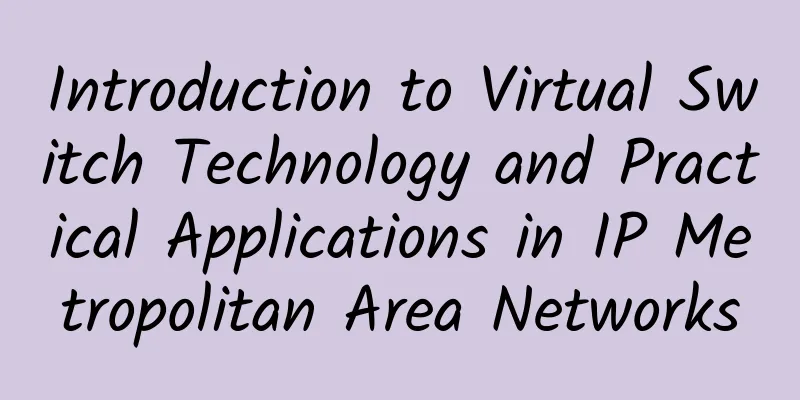Introduction to Virtual Switch Technology and Practical Applications in IP Metropolitan Area Networks

|
With the continuous development of information technology, virtualized networks have gradually shown great development potential. Compared with traditional switches, virtual switches have great advantages in all aspects. The application of virtual switch technology in the future communications industry is imperative. Do you know about virtual switch technology? Do you know the principle of virtual switch? How can IP metropolitan area network introduce virtual switch technology? 1. Development of Virtual Switch Technology As user access bandwidth increases from 10M to 100M, a large number of terminals and applications such as the Internet and the Internet of Things are accessed and carried from the edge of the network. As a comprehensive bearer network for Internet applications, self-operated telecoms and key businesses, the IP metropolitan area network is facing problems such as doubling of traffic, exhaustion of IPv4 addresses, differentiated bearer requirements, insufficient network elasticity and security, and urgently needs to introduce a series of technologies such as IPv6/SDN/NFV/virtualization to optimize and adjust network element deployment, network architecture and network controllability. In recent years, with the rapid development of informatization, more and more scholars have begun to study virtualized networks, and virtual switches have become a trend in the development of communications. At present, network servers already have the function of supporting virtual machines. Server virtualization promotes the virtualization of computer room networks. When physical servers are streamlined and merged into virtual platforms, virtualization technology is used to reuse real physical devices to form virtual switches and other components to provide network services. Compared with traditional switches, virtual switches have simpler network functions at the data link layer. In the future, virtual switches will become the core of building virtual network platforms. 2. Introduction to Virtual Switch Technology 1. Virtual switch principle According to the topology structure, the principle of virtual switch technology is relatively simple. In essence, this technology is to logically integrate multiple physically connected switches. The characteristics of this technology are that the communication reliability is stronger, the work efficiency is improved, and the bandwidth capacity of the system is increased. Compared with traditional switches, virtual switches can not only realize the load balancing and redundancy required by the STP and VRRP protocols, but also reduce the number of network devices and simplify the network architecture, thereby alleviating the pressure of system management and maintenance. The working principle diagram of virtual switch technology is shown below: In the application mode of virtual switch technology, SW1 and SW2, SW3 and SW4, SW5 and SW6 are virtualized to convert them into a logical switch, namely SWA, SWB, SWC. As for SWB, SW3 and SW4 can be regarded as connected to the same switch WSA. This process uses EtherChannel technology to achieve load balancing and redundancy, eliminating the need for STP and VRRP protocols. In this way, switching loops in the network can be avoided, effectively simplifying the network. 2. Topology collection In topology collection, each member of the virtual switch collects topological relationships based on forwarding messages to each other and to adjacent members. The relevant topological information of each member together constitutes the message, such as device number, priority, member bridge MAC address, adjacent connection relationship and system running time, etc. The topology information that each device has learned will be recorded with the help of the local main control board, so that each member can be effectively managed. At first, only the local topology information is recorded, and after the virtual switch port is up, the topology of the entire system can be effectively collected according to the following process:
3. Role Election After the topology collection process, the topology information of each member device is complete. This process is also called topology convergence. After the topology convergence is completed, role election is required. When the topology changes, such as the establishment of a virtual switch system, the addition or subtraction of members, the merging or splitting of virtual switches, etc., each member device in the virtual switch system will assign a Master or Slave role to each member device under the mutual forwarding of election messages. The rules for role election follow the following six points:
During the Master device election process, the only member device is elected in order according to the above rules to determine the Master, and the remaining members are Slaves. 4. Management and maintenance After the role election is completed, all device members synchronize their configurations with a master device that manages the member numbers of the entire virtual switching system and manages and maintains all member resources. (1) Configuration synchronization After the virtual switch system is established, the main contents involve two processes, namely initializing batch synchronization and running real-time synchronization.
Once multiple devices select the Master device in the role election, the virtual switch system is formed. The Master device first runs the local startup configuration program and then synchronously configures multiple Slave devices. When the virtual switch system is established, it means that the configuration of all devices is complete. When a new member device is added to the virtual switch system, the Slave role will be assigned to it first. The Master will complete the batch synchronization in the form of batch synchronization, and the local configuration file will not be started.
After the virtual switch system is established, the Master device is used as the system manager to operate the member device configuration required by the user and reflect the user's usage needs. Under the management of the Master device, the user configuration will be synchronized on other Slave devices. In this way, the real-time synchronization of the Master and Slave device configurations within the virtual switch can be achieved and exist in the form of a single network device during the network operation process. (2) Member Number In order to improve the marking and management level of the virtual switch system, all members need to be numbered. Taking the addition of interface numbers in the virtual switch member number information as an example, for a general single centralized switch, a one-dimensional format is used to represent the interface number, with 1 as the initial value. When multiple switches are virtualized into one, the initial value will be replaced by the member number value. For a single distributed device, the interface number is generally represented in a three-dimensional format, such as GigabitEthernet1/1/1. The establishment of a virtual switch will change the interface number, that is, GigabitEthernet2/1/1. Not only will the member number be introduced in the interface number, but the application of file system management is also the same. Therefore, all device member numbers are unique in the virtual switch system. When the member number is the same, or the member number in the system conflicts with the newly added device, it will affect the system management order, and the establishment of the virtual switch system cannot be realized, or the system cannot introduce new member devices. To solve this problem, member numbers should be planned and configured uniformly before the system is established. At the same time, relevant mechanisms should be established to handle conflicts in numbers between devices, providing strong protection for the uniqueness of member numbers. (3) Topology maintenance Topology maintenance mainly involves two aspects, namely the continuous increase and decrease of devices. In view of these situations, updating the topology is crucial.
In terms of adding member devices, if a new device wants to join the virtual switch system, you need to select the corresponding system processing mechanism according to the device status. If the virtual switch system is not formed by the newly added device, the Slave role needs to be assigned to the device. When a virtual switch system is formed by adding devices, it means that two virtual switches are merged. At this time, the two devices need to compete based on the role election rules. If the election is successful, it means that some ports and a backup main control board are added. If it fails, after restarting the system, the device will be assigned the Slave role and added to the system.
In terms of the departure of member devices, if the adjacent devices are directly connected, then when a fault occurs between one or two devices, the other device will immediately propagate the information of the departure of the previous device to other devices in the system. If the two adjacent devices are cross-connected or cannot be directly connected, then when a fault occurs in one device or link, the other device can only determine the departure of the previous device based on the timeout of the real-time message between the system devices, and propagate the information to other devices in the system. Once the departure of a device is confirmed, the role of the device that left needs to be determined based on the topology information. If the role that left belongs to the Master, then all devices need to update the local topology under the role election. If the device that left belongs to the Slave, then the topology can be directly updated without the need for a re-election of the role. 3. Virtual switch technology implementation method 1. Cascade mode Two or more switches are connected through RJ-45 ports via optical fiber or twisted pair cables. This method is called cascading. When the topology is bus-type, ordinary ports can be used for cascading. When the topology is star-shaped, a dedicated cascading port Uplink port is required. The advantage of the bus type is the transmission distance, while the advantage of the star type is the maintenance of network bandwidth. The biggest role of cascading is still reflected in extending the transmission distance. For example, in 10Base-T, 100Base-TX and 1000Base-T Ethernet, the maximum network transmission distance can reach 200 meters through cascading. As can be seen from the above, the implementation of cascading is relatively simple. However, as the number of cascade layers increases, the efficiency of the network will be affected, especially the signal delay of the last layer will be greater. Therefore, when implementing cascading technology, it is necessary not only to eliminate loops within the network and provide redundant links, but also to control the number of cascade layers, which generally does not exceed 4 layers. At the same time, when the number of cascaded switches increases, in addition to managing and configuring each logically independent switch, the bottleneck problem generated during network forwarding must also be considered. So in general, cascading technology solves the requirements of transmission distance and ports to a certain extent, but the overall performance is not very good. In fact, cascading technology only increases the number of available ports, and does not simplify network devices in terms of topology logic, which does not play a big role in improving the overall network performance. 2. Stacking mode Stacking technology is to combine the dedicated stacking modules on multiple switches through dedicated stacking cables to provide more available ports and capacity. Unlike cascading, the units formed after stacking can be logically regarded as a switch to be controlled and managed. This greatly reduces the workload in the management and maintenance process. However, the compatibility of stacking technology is not high, and different brands cannot be stacked with each other. Generally speaking, stacking technology can be divided into two modes: daisy chain stacking and star stacking. (1) Daisy chain stacking mode The daisy chain stacking method is very similar to the cascading method mentioned in the previous section, but special stacking cables are still required for connection. The connection between devices is shown in the figure below. But in fact, this method must use the STP spanning tree protocol, otherwise it is easy to cause a broadcast storm. When any device or link in the daisy chain stack has a problem, the STP protocol needs to be re-run, which will cause network interruption. At the same time, if this method is used, the path for data transmission between devices is too long, resulting in low efficiency. In general, the daisy chain stacking method is the same as the cascading method. Its main contribution is to increase the number of available ports. Even the efficiency of a single port is far lower than that of the cascading technology. In addition, the transmission distance can only be achieved within a few ports, which is far inferior to the cascading technology. Therefore, the daisy chain stacking method is rarely used in most cases. (2) Star stacking mode Compared with daisy chain stacking, star stacking has much better performance. Star stacking is to connect all devices uplink to the hardware switching stacking center based on special integrated circuits of the main device through high-speed stacking ports. The switching capacity of this unit is generally around 10~32G, which limits the number of stacking layers. In the star stacking diagram (above), since all the Slave stacking modules are centrally connected to the stacking center of the Master device, only three exchanges are needed to achieve data forwarding between any two end nodes. This is equivalent to the Master device being only one level apart from all the Slave devices. This greatly improves the forwarding rate between system members and the efficiency of single-port data forwarding. In addition, in the topology logic, all stacked devices share one IP address, that is, they appear as one device unit to the outside world. This facilitates the management and maintenance of stacked devices. However, the distance of a star stacking generally cannot exceed 2 meters, and the Matrix interface used to increase bandwidth is not universal. At the same time, the dedicated stacking port used to achieve stacking cannot be used to connect other network devices. From the above analysis, we can know that although the traditional stacking technology can provide more available ports and better bandwidth, and is relatively convenient in management and maintenance, it can basically only be implemented in the same rack, with a short connection distance and poor compatibility. 3. Cluster Mode Cluster technology is actually a combination of cascading technology and stacking technology. Cluster technology not only has the same connection distance as cascading technology, but also has the bandwidth and higher forwarding efficiency of stacking technology. It can also be managed and maintained as a single unit logically. The use of cluster technology can not only dynamically collect and maintain topology information, upgrade and manage member switches, but also greatly save IP resources. The cluster switching system mainly consists of four roles: the command switch responsible for cluster establishment, management and maintenance, the member switch responsible for accepting management, the backup switch responsible for backing up the command switch, and the candidate switch that can join the system and become a member. The commonly used protocols are mainly the neighbor discovery protocol used to discover adjacent devices, the topology mobile protocol used to manage and maintain the cluster system topology, and the cluster management protocol used to implement management functions such as system establishment, adding and removing members, and updating configuration. After the cluster system is established, each member switch will periodically report its current status to the command switch through handshake messages. Then adjust its own status through the command of the command switch. In addition, the cluster management also sets the command directional function. The command directional function means that the command issued by the command switch can be sent to a specific member switch in a directional manner without broadcasting to the entire network, which also greatly improves the operation efficiency of the system. Although it can greatly reduce the workload of management and maintenance, cluster technology is not perfect. Especially in terms of compatibility, different manufacturers generally have their own dedicated protocols when implementing clusters. This means that clusters cannot be implemented between devices from different manufacturers, but they can be cascaded. Even for devices produced by the same manufacturer, not all models can be clustered at will, and fixed models are required. 4. Application Examples of IP Metropolitan Area Network Virtual Switch Technology The following is an example of a city (the city has about 300,000 broadband users, including about 140,000 IPTV users, a peak user number of about 200,000, and 3,500 dedicated line users) to introduce the application of virtual switches in IP metropolitan area networks. The three nodes a, b, and c involved have a shortage of aggregation layer switch port resources, which makes maintenance difficult. Now try to introduce virtual switches in the network and implement the following rules:
At present, the metropolitan area network is mainly based on the N:1 virtualization of network equipment to initially build a resource pool. Under the 1:N virtualization operation of network equipment, the redistribution of network resources can be completed. At the same time, with the support of network path virtualization technology, end-to-end network virtualization deployment can be realized. The node metropolitan area network virtual switch has been running for more than a year, and its stability is relatively high. Compared with the expected effect, the virtual machine network operation performance is relatively ideal. By introducing virtual switch technology, the failure rate is effectively controlled, the operation and maintenance workload is also reduced, and the links and ports are fully utilized, which reflects a great advantage in the overall investment cost. At the same time, with the development of the metropolitan area network in the later period, a substantial increase in operation speed has also become possible. 5. Virtual switch technology application defects It is undeniable that there are still some defects in the current application of virtual switch technology, which requires us to conduct in-depth research, propose effective improvement measures, and promote the development of virtual switch technology. Based on the current reality, the future transformation of the metropolitan area network of operators can be divided into three stages: the first is network virtualization, reducing the network level, and making the metropolitan area network flatter and simpler. The second is to build a resource pool. After the first stage of virtualization, the originally scattered nodes are gathered into several large network nodes, which have a certain pooling capability. In the second stage, NFV and cloud computing technologies can be introduced, such as virtualized firewalls, virtualized BRAS (broadband access servers) and virtualized SR, etc., to gradually realize the cloudification and softwareization of the metropolitan area network. The third is to further enhance the performance of large POP nodes in the metropolitan area network, such as solving the problem of insufficient service labels after the original nodes are gathered and concentrated, and further introducing network virtualization, function virtualization and dynamic virtual channel technology, etc., so as to improve the service capabilities of large POP nodes in the metropolitan area network. VI. Conclusion With the increasing development of science and technology and the continuous maturity of virtual switch technology, it is believed that in the future urban telecommunications construction and development process, virtual switch technology will have huge development space and application value. |
Recommend
A comprehensive analysis of IoT positioning technology! Positioning is moving from outdoor to indoor
As early as the 15th century, when humans began t...
China Mobile has built more than 410,000 5G base stations
On April 25, China Mobile General Manager Dong Xi...
EtherNetservers: Los Angeles VPS starts at $14.95 per year, 1GB/40GB/1TB, supports Alipay/PayPal
EtherNetservers' special annual VPS has alway...
In 2018, Huawei invites ecosystem partners to jointly stimulate the unlimited potential of the ecosystem
[51CTO.com original article] At 9:30 am on March ...
The cutting-edge of Internet technology - a comprehensive analysis of TSN
[[271597]] TSN is the abbreviation of time-sensit...
Chinese companies are strong in 5G R&D, spectrum strategy planning needs to be implemented
In recent times, 5G has become popular in the cir...
Node.js knowledge - How to set cookie information in HTTP request and response
[[398674]] HTTP Cookie[1] is a small piece of dat...
A quick overview of 5G industry developments in March 2021
After the rapid development in 2020, 2021 is a cr...
[Black Friday] Friendhosting 40% off, 13 data center VPS monthly payment starts from 1.8 euros
Friendhosting released this year's Black Frid...
One-stop integration of ecology and scenarios? Let’s take a look at the “sharing” of mini programs
01 Mini Program Breakthrough Plan Since Alipay op...
IKIHOST: $3/month-AMD Ryzen/2GB/30G NVMe/Unlimited traffic @10Gbps/Salt Lake City Data Center
This is the first time that IKIHOST has appeared ...
LiCloud: $16.99/year KVM-756MB/10GB/399GB/Hong Kong Data Center
In April, I shared information about LiCloud.io. ...
ICANN to replace Internet Domain Name System (DNS) encryption keys for first time
Recently, David Conrad, Chief Technology Officer ...
A look back at five major outages in 2019
Any time a network service outage occurs, it can ...
Ultra-low energy consumption Passive Wi-Fi speed exceeds 11Mbps
According to foreign media reports, a research te...









